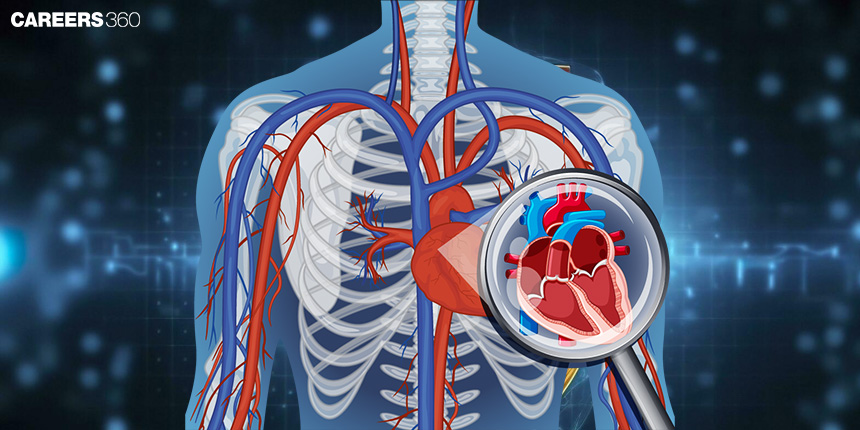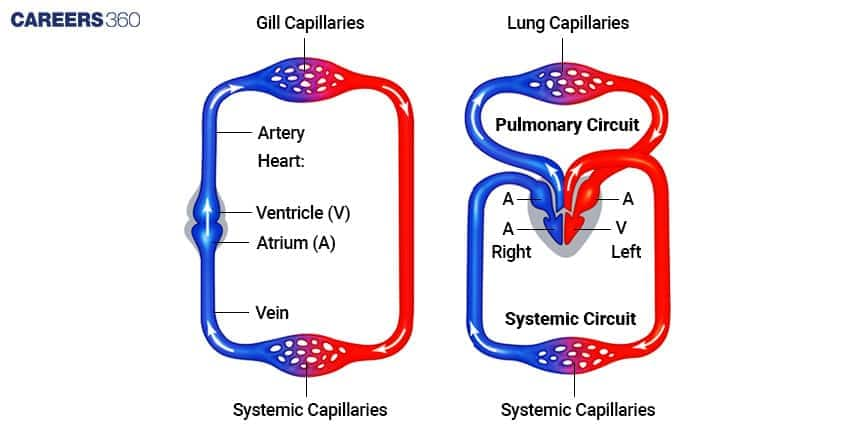Double Circulation In Humans: Definition, Diagram, Flow Chart
Double circulation is the main characteristic by which the human circulatory system favours the efficient transport of oxygen and nutrients. In the double circulatory system, blood flows through the heart twice for each complete circuit: once in the pulmonary circuit (between the heart and lungs), to facilitate oxygenation, and secondly, within the systemic circuit (between the heart and body), to provide oxygen and nutrients. By comparing the difference between single and double circulation, we can see that the double circulation of blood prevents the mixing of oxygenated and deoxygenated blood, which enhances metabolic efficiency. This is an important part of the chapter Body Fluids And Circulation in Biology.
NEET 2025: Mock Test Series | Syllabus | High Scoring Topics | PYQs
NEET Important PYQ's Subject wise: Physics | Chemistry | Biology
New: Meet Careers360 B.Tech/NEET Experts in your City | Book your Seat now
- The Circulatory System
- Types of Circulatory Systems
- Pulmonary Circulation
- Double Circulation
- Common Disorders Related To Double Circulation

The Circulatory System
The circulatory system supplies food and gases to all parts of the body and removes metabolic waste from it. In respiration, the circulatory system is directly related to the heart and lungs concerning the circulation and purification of blood. But does the heart have a lone role in purification? Let us look in detail at double circulation and the relative organs.
Also Read
Types of Circulatory Systems

There are two types of circulatory systems found in animals: the open circulatory system and the closed circulatory system. Most mammals, including human beings, have a double circulatory system. The closed circulatory system is further divided according to the number of circulations blood goes through in the heart.
Single Circulation
Blood passes through the heart once for every complete circuit through the body in a single circulatory system. Blood flows from the heart to the gills for purification and is then distributed to various body parts. Only one cardiac cycle is completed, hence the name single circulation. Single circulation is mainly seen in fish, amphibians, and some reptiles.
Double Circulation
Double circulation is a pattern in which blood circulation involves two routes—one for oxygenated blood and another for deoxygenated blood. The key organ standing behind double circulation in human beings is the human heart, which is divided into four chambers: left atrium, right atrium, left ventricle, and right ventricle. The heart only connects to the lungs through the pulmonary artery and vein.
It is the dual blood pathways, namely pulmonary and systemic:
Systemic Circulation
Systemic circulation refers to the flow of oxygenated blood supplied by the left ventricle to the capillaries of tissues. The process is stated below.
The oxygen-rich blood flows into the aorta, and it in turn distributes them throughout the body. Veins and venules collect the deoxygenated blood having carbon dioxide back from various parts of the body.
The deoxygenated blood gets pumped again to the superior vena cava.
From the superior vena cava, deoxygenated blood again goes back to the right atrium.
The right atrium supplies the deoxygenated blood to the right ventricle. This blood will be to be used in the pulmonary circulation.
Pulmonary Circulation
The blood circulation comes in between the right atrium to the left atrium. Following is the process:
The pulmonary artery picks up blood from the right ventricle and carries it into the lungs for oxygenation.
From here, following purification, the oxygenated blood is pumped back through the pulmonary vein to reach the left atrium and thereby enter the left ventricle.
The oxygenated blood thereafter gets pumped into the aorta to complete its course around the body.
Double Circulation
Double circulation ensures that oxygenated blood does not interfere with deoxygenated blood. As such, the body at any given time is assured of a supply of oxygen and efficiency would be improved. This would allow mammals to maintain their body temperatures. Apart from double circulation, there also exists a third portal system to improve the efficiency of circulation.
Common Disorders Related To Double Circulation
Congenital Heart Defects: Structural defects of the heart which are present at birth, can directly influence double circulation.
Cardiovascular Diseases: A fusion of the defects in the heart and circulatory systems, for instance, coronary artery disease—a disease linked with a heart that can directly influence the performance of circulation.
Also Read
Recommended video on Double Circulation in Humans
Frequently Asked Questions (FAQs)
Double circulation refers to oxygenated and deoxygenated blood pumped through two distinct flows. It is important because it ensures a constant supply of oxygen to the body and efficient riddance of carbon dioxide.
Double circulation is when blood passes through the heart twice in every complete circuit. In single circulation, it only passes once for the whole circuit. In the former, there is no mixing of oxygenated and deoxygenated blood.
The primary parts are the left atrium, right atrium, left ventricle, and corresponding right ventricle.
Systemic blood flow refers to the current of blood from the left ventricle through and around the body's organs before it finds its way back to the right atrium.
A few of the more common disorders would include congenital heart defects and cardiovascular diseases such as coronary artery disease.
Also Read
29 Nov'24 01:19 PM
27 Nov'24 07:39 PM
27 Nov'24 07:15 PM
27 Nov'24 05:11 PM
26 Nov'24 08:14 PM
26 Nov'24 06:50 PM
26 Nov'24 05:51 PM
26 Nov'24 04:44 PM
26 Nov'24 03:52 PM
26 Nov'24 02:55 PM